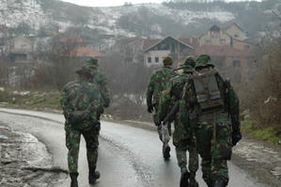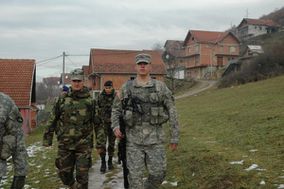Kosovo 1: North Kosovo. One eye towards Belgrade, the other towards Pristina
 (B2)
(B2)
“Not trusting calm to apparent calm is the difficulty of this mission” says Captain Ucheida, of the Franco-German brigade, who is finishing his 4-month mission. When he transmits the instruction to the (French) marine infantry regiment which relieves them, it is this instruction that he wants to pass on. “It can be quiet. It gets tense in the morning and catches fire in the afternoon”.
Housed in “La Concession”, the building which continues to serve as a cultural center… and as a nightclub on Friday evenings!, the soldiers have an observation post of choice there. They overlook the main Mitrovica bridge (renamed the “Austerlitz” bridge by the KFIR) guarded night and day by the men of the KPS (Kosovar police) and the UNMIK Police (UN).
Mitrovica city of separation?
Such a deployment of force may seem superfluous, as the city breathes life. But Mitrovica is a symbolic city, a border city. City symbol. It was there that the incidents broke out which left a total of 19 dead and several hundred injured. The Ibar River separates “Albanian Kosovo” to the south from “Serbian Kosovo” to the north. This border is not really perfect. Indeed, a clear majority (about 100.000) of "Kosovars of Serbian origin" (KOS in NATO's "politically correct" language) live in other regions, in Pristina or in the south of the country, in the American zone. . This northern Kosovo, with arid lands of ore extraction and mountains, with impassable roads in winter, is home to only 60.000 Serbs. Only a few dozen Kosovars of Albanian origin (KOA) remained, in Mitrovica, in the mixed residential areas – the towers or the Little Bosnia district – and in a few Albanian village enclaves. This North lives facing Belgrade. Election posters show the different political parties in the presidential campaign. And polling stations were opened for the presidential election in Serbia. On the other hand, almost no voters took part in the recent legislative elections in Kosovo: 43 in the Nothing Hill sector according to Captain Petit!
Election posters show the different political parties in the presidential campaign. And polling stations were opened for the presidential election in Serbia. On the other hand, almost no voters took part in the recent legislative elections in Kosovo: 43 in the Nothing Hill sector according to Captain Petit!
The North looks at Serbia above all, the Albanians Pristina
The KPS – the Kosovo police – operates everywhere. Despite an apparent unity, the police are “Serbian” in the north, and overwhelmingly Albanian in the rest of the country. The energy comes from Serbia in the north, from Kosovo in the south. Serbian police officers also receive a salary from Belgrade. Serbian pensioners a pension… The cars display the Serbian plates “KM” for “Kosovo i Metohija” (Serbian name of Kosovo), the Kosovars have a sign “KS” between several digits. Even the mobile telephone networks are separate: Serbian in the north (with 38 as the code), Kosovar elsewhere (with 377, the code for… Monaco, the Telecoms of the Principality managing the network here). If the separation is clearly visible, the nestings are more discreet. Serbia also supplies electricity to Kosovo. A few vehicles circulate without plates: inhabitants of an enclave returning to see their families, Albanians or Serbs in transit in the other “zone”, or stolen vehicles. The police decided to turn a blind eye. Such an “Albanian” village, located in the heights (the peaks culminate around 2000 meters), in winter, can only travel through the “Serbian zone”, thus becoming a real enclave.
 “High-visibility, low-profile”. This is the doctrine of NATO
“High-visibility, low-profile”. This is the doctrine of NATO
In other words, show yourself as much as possible, but keep a non-aggressive profile. The soldiers circulate without bulletproof vests but these remain in the vehicles). Is the submachine gun with a magazine, clearly visible. But it is not engaged (the bullet is normally not engaged in the barrel). And it is worn on the back, in ordinary times. No question of strolling through the villages with a weapon at the hip. During our three days of patrol, no European soldier will have deviated from this rule. The Americans remain an exception. " They are traumatized by what is happening in Iraq and believe that it is everywhere Iraq confides a soldier.
On patrol in the North
The KTM (Kosovo Tactical Reserve Maneuver Battalion) was placed on alert in the northern area. The Kfor reserve battalion, made up of the 2nd Infantry Battalion (Portuguese) led by Colonel Magalhaes, regularly patrols MItrovica. Objective: today: the “Barbecue” (monument to the glory of the mining heroes of the former Yugoslavia which dominates the city) via “Montmartre” (the residential district of Mitrovica) and return via “Passy”. At each zone entry, stop, the robust military radio of the Portuguese crackles. The patrol reports to its company PC. Only problem: the Portuguese radio is not connected to the French PC of the Concession a few meters away. If there is a problem, it will then be up to the headquarters to communicate with each other and ensure the relay... The Portuguese methodically take up any political poster or poster announcing a rally. Digital photography, typographical survey and summary are recorded in a notebook and will be the subject of a report which will go up to Headquarters. " We also note foreign vehicles – this goes back to Interpol ". as well as prices. " Any sudden increase can be a sign of tension explains Second Lieutenant Laroche, in charge of information at the North task force.
"Nothing Hill" the last advanced camp of Kfor
More rudimentary than the others. We are indeed in the middle of nowhere. A mixed Franco-American patrol takes over, with which we will do the last kilometers that separate from Serbia. A detachment of the Iowa National Guard, usually stationed in southern Kosovo, took up duty in the north. By rotation, to get to know the area better “, each NATO task force sends a company to the area. " That it's the Americans is a coincidence “say the soldiers. But the strategic interest escapes no one. Show the Serbs on their border – pardon the “administrative boundary” – that the Americans, nine years after the NATO strikes, are still there. The Serbs know full well that hitting an American does not have the same weight as hitting a European.  And indeed, the big fellows of the Iowa National Guard, with slow and relaxed steps, despite everything, with the 50-star patch on their shoulders, do not really go unnoticed in this rather empty village of Lezak. The population fulfills its obligations. One eye apparently distracted, the other alert. Politics is not far away. The Serb we met, who works at the electrical “relay”, makes the sign of the three fingers, by way of goodbye, the rallying sign of the Serbian radicals. Message well received. Another, responsible for "delivering the mail", begins a conversation that turns into a controversy. Harsher words (“Albanian motherfuckers”) follow conventional words, which the interpreter is careful not to translate, smoothing the conversation. The patrol picks up to avoid any further provocation. The man apparently has other functions than delivering the mail…
And indeed, the big fellows of the Iowa National Guard, with slow and relaxed steps, despite everything, with the 50-star patch on their shoulders, do not really go unnoticed in this rather empty village of Lezak. The population fulfills its obligations. One eye apparently distracted, the other alert. Politics is not far away. The Serb we met, who works at the electrical “relay”, makes the sign of the three fingers, by way of goodbye, the rallying sign of the Serbian radicals. Message well received. Another, responsible for "delivering the mail", begins a conversation that turns into a controversy. Harsher words (“Albanian motherfuckers”) follow conventional words, which the interpreter is careful not to translate, smoothing the conversation. The patrol picks up to avoid any further provocation. The man apparently has other functions than delivering the mail…
Gate 1

It is, as its name suggests, the main gateway between Belgrade and Serbia to the north and Pristina and Kosovo to the south. This will surely be one of the main security issues in the coming weeks. Who holds this position will ensure the territorial integrity of the province. Admittedly, we do not say “border” officially, we speak of “northern administrative limit”. But the reality is similar. A customs post, police officers from the Unmik on one side, from the KPS on the other. And two visions of control. At the entrance without the territory, it is the KPS which officiates. The welcome is rather good-natured, a quick glance, usually coupled with a handshake when it's a neighbor or an acquaintance. At the exit, the control is more severe. The Unmik customs officer – a Ghanaian during our visit – is more rigorous. Seeing the Kfor soldiers, a passenger makes the sign of the three fingers, all hilarious. Needless to say that no Kosovar plate ventures at Gate 1. End of the journey…
Kfor in a nutshell
With 16 men today, the NATO force (KFOR) was deployed from June 000, 12, after a military-technical agreement with the Serbs on their military withdrawal (June 1999) and the resolution of the UN (June 9). Since 10, it has been organized into five Multinational Task Forces (MNTF), crisscrossing the entire territory, commanded by a framework nation: United States (east), Ireland (and United Kingdom, in the center), Turkey (alternately with the Germany, south), Italy (west), France (north). It includes two forces – not sectorized – the KTM (reserve battalion) and the MSU (police force) which are intended to intervene throughout Kosovo. Since September 2006, 1, KFOR has been commanded by French Lieutenant General Xavier Bout de Marnhac. The headquarters is based in Pristina at “Film city”.
(Nicolas Gros-Verheyde, in Mitrovica, Pristina, and North Kosovo)
Photo quoted: NGV - January 2008

Comments closed.